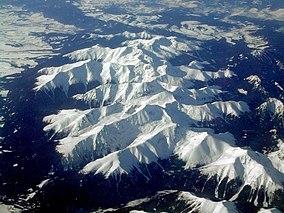Tatra National Park, Slovakia
| Tatra National Park Tatranský národný park | |
|---|---|
 Western Tatras
 Tatra mountains, North Central Slovakia | |
| Coordinates | 49°10′49″N 19°55′10″E / 49.18028°N 19.91944°E |
| Area | 738 km2 (284.9 mi2) |
| Established | 1 January 1949 |
| Governing body | Správa Tatranského národného parku (The administration of the Tatra National Park) |

Tatra(s) National Park (Slovak: Tatranský národný park; abbr. TANAP) is one of the nine national parks in Slovakia. It is situated in North Central Slovakia in the Tatra Mountains. The park is important for protecting a diverse variety of flora and fauna, with many endemic species, including the Tatra chamois.
The Tatra Mountains form a natural border between Slovakia to the north and
Geography
The Tatra National Park protects the Slovak areas of the High Tatras mountain range in the Eastern Tatras (Východné Tatry) ranges, and areas of the Western Tatras (Západné Tatry) ranges.[1] The west part of the Tatra National Park is situated in the Žilina Region and the east part in the Prešov Region.
The national park covers an area of 738 km2 (284.9 mi2), and the buffer zone around the park covers an area of 307 km2 (118.5 mi2); 1045 km2 together.[2] The park offers 600 km of hiking trails[3] and 16 marked and maintained bike trails.
Mountains
The Western Tatras are divided into Osobitá, Roháče, Sivý vrch (literally Grey Mountain), Liptovské Tatry (Liptov Tatras), Liptovské Kopy, Červené vrchy (Red Mountains). The Eastern Tatras consist of High Tatras (Vysoké Tatry) and Belianske Tatras (Belianske Tatry).
The highest peak in Slovakia at 2,655 metres (8,711 ft) in elevation, Gerlachovský štít, is located within the park. It is also the highest point in the Tatra Mountains and the Carpathian Mountains. Bystrá is the highest mountain in the Western Tatras at 2,248 metres (7,375 ft), and Havran mountain (English: Raven) is the highest point in the Belianske Tatras at 2,152 metres (7,060 ft).
Lakes and streams
There are more than a hundred
The area around the settlement of

Caves
About 300 caves are located within the national park, however Belianska Cave (Belianska jaskyňa) is the only one open to public. It is located near the village of Lendak.
The longest cave system discovered to date is the Cave of Javorinka.
Park history
Tatra National Park was established on 1 January 1949 and it is the oldest national park in Slovakia. In 1987, a section of the Western Tatras was added to the national park.
In 1992 the national park became a part of the
The areas of the park and its buffer zone were adjusted in 2003. Since 2004, the national park belongs to the Natura 2000 ecological network.
Ecology and biota
The geological composition, soil properties and climate conditions all contribute to the original flora and fauna in the park.[5]

Flora
Almost two thirds of the park are covered with forests, mainly with
About 1,300 species of

Fauna
Animals are represented by 115 species of birds, 42 mammals, 8 reptiles, and 3 amphibians. There are also many
Mammals in the park include the endemic
See also
- Tatra National Park, Poland — biosphere reserve partner.
- Western Carpathians Ranges
- List of national parks of Slovakia
References
- ^ "Inorganic nature". Tatras National Park. n.d. Archived from the original on February 21, 2007. Retrieved May 21, 2007.
- ^ "A Man and nature". Tatras National Park. n.d. Archived from the original on February 21, 2007. Retrieved May 21, 2007.
- ^ a b "Príroda TANAPu [Nature of TANAP]" (in Slovak). Štátne lesy TANAPu. n.d. Archived from the original on June 9, 2007. Retrieved May 21, 2007.
- ^ "Europe & North America: 297 biosphere reserves in 36 countries". Ecological Sciences for Sustainable Development. UNESCO. Archived from the original on 2015-08-05. Retrieved 2016-01-31.
- ^ a b c "Living nature". Tatras National Park. n.d. Archived from the original on February 21, 2007. Retrieved May 23, 2007.
- ^ Jstor.org: Branchinecta paludosa
- ^ "Rupicapra rupicapra ssp. tatrica". International Union for Conservation of Nature and Natural Resources. n.d. Archived from the original on December 13, 2007. Retrieved June 18, 2007.
